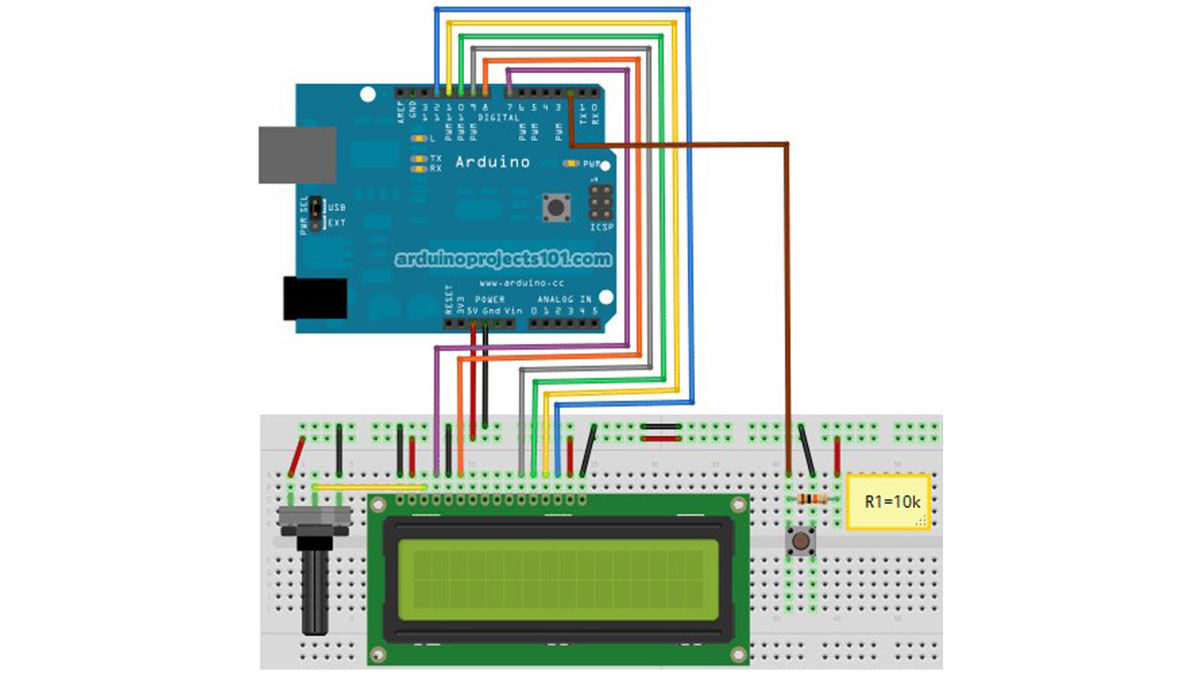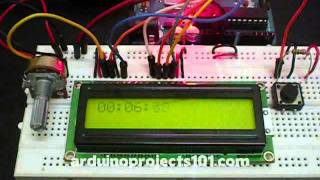Arduino projects, running stopwatch on arduino.
Arduino projects, running stopwatch on arduino.
Parts List;
1) 1x 16×2 parallel LCD display (compatible with Hitachi HD44780 driver)
2) 1x Arduino
3) 1x 10kΩ potentiometer
4) 1x 10kΩ resistor
5) 1x switch
6) Jumper wire
Instruction;
1) Connect all jumper wire as shown in diagram.

2) Connect digital input from switch to digital pin 2.
Upload this code to your arduino
/*
Stopwatch
Run stopwatch with arduino.
Code based on: http://danthompsonsblog.blogspot.com/2008/11/timecode-based-stopwatch.html
Coded by: arduinoprojects101.com
*/
// include the library code:
#include <LiquidCrystal.h>
// initialize the library with the numbers of the interface pins
LiquidCrystal lcd(7, 8, 9, 10, 11, 12);
int ledPin = 13; // LED connected to digital pin 13
int buttonPin = 2; // button on pin 2
int value = LOW; // previous value of the LED
int buttonState; // variable to store button state
int lastButtonState; // variable to store last button state
int blinking; // condition for blinking - timer is timing
int frameRate = 100; // the frame rate (frames per second) at which the stopwatch runs - Change to suit
long interval = (1000/frameRate); // blink interval
long previousMillis = 0; // variable to store last time LED was updated
long startTime ; // start time for stop watch
long elapsedTime ; // elapsed time for stop watch
int fractional; // variable used to store fractional part of Frames
int fractionalSecs; // variable used to store fractional part of Seconds
int fractionalMins; // variable used to store fractional part of Minutes
int elapsedFrames; // elapsed frames for stop watch
int elapsedSeconds; // elapsed seconds for stop watch
int elapsedMinutes; // elapsed Minutes for stop watch
char buf[10]; // string buffer for itoa function
void setup()
{
lcd.begin(16, 2); // intialise the LCD.
pinMode(ledPin, OUTPUT); // sets the digital pin as output
pinMode(buttonPin, INPUT); // not really necessary, pins default to INPUT anyway
digitalWrite(buttonPin, HIGH); // turn on pullup resistors. Wire button so that press shorts pin to ground.
}
void loop(){
digitalWrite(ledPin, LOW); // Initiate LED and Step Pin States
buttonState = digitalRead(buttonPin); // Check for button press, read the button state and store
// check for a high to low transition if true then found a new button press while clock is not running - start the clock
if (buttonState == LOW && lastButtonState == HIGH && blinking == false){
startTime = millis(); // store the start time
blinking = true; // turn on blinking while timing
delay(10); // short delay to debounce switch
lastButtonState = buttonState; // store buttonState in lastButtonState, to compare next time
}
// check for a high to low transition if true then found a new button press while clock is running - stop the clock and report
else if (buttonState == LOW && lastButtonState == HIGH && blinking == true){
blinking = false; // turn off blinking, all done timing
lastButtonState = buttonState; // store buttonState in lastButtonState, to compare next time
// Routine to report elapsed time
elapsedTime = millis() - startTime; // store elapsed time
elapsedMinutes = (elapsedTime / 60000L);
elapsedSeconds = (elapsedTime / 1000L); // divide by 1000 to convert to seconds - then cast to an int to print
elapsedFrames = (elapsedTime / interval); // divide by 100 to convert to 1/100 of a second - then cast to an int to print
fractional = (int)(elapsedFrames % frameRate); // use modulo operator to get fractional part of 100 Seconds
fractionalSecs = (int)(elapsedSeconds % 60L); // use modulo operator to get fractional part of 60 Seconds
fractionalMins = (int)(elapsedMinutes % 60L); // use modulo operator to get fractional part of 60 Minutes
lcd.clear(); // clear the LDC
if (fractionalMins < 10){ // pad in leading zeros
lcd.print("0"); // add a zero
}
lcd.print(itoa(fractionalMins, buf, 10)); // convert the int to a string and print a fractional part of 60 Minutes to the LCD
lcd.print(":"); //print a colan.
if (fractionalSecs < 10){ // pad in leading zeros
lcd.print("0"); // add a zero
}
lcd.print(itoa(fractionalSecs, buf, 10)); // convert the int to a string and print a fractional part of 60 Seconds to the LCD
lcd.print(":"); //print a colan.
if (fractional < 10){ // pad in leading zeros
lcd.print("0"); // add a zero
}
lcd.print(itoa(fractional, buf, 10)); // convert the int to a string and print a fractional part of 25 Frames to the LCD
}
else{
lastButtonState = buttonState; // store buttonState in lastButtonState, to compare next time
}
// run commands at the specified time interval
// blink routine - blink the LED while timing
// check to see if it's time to blink the LED; that is, the difference
// between the current time and last time we blinked the LED is larger than
// the interval at which we want to blink the LED.
if ( (millis() - previousMillis > interval) ) {
if (blinking == true){
previousMillis = millis(); // remember the last time we blinked the LED
digitalWrite(ledPin, HIGH); // Pulse the LED for Visual Feedback
elapsedTime = millis() - startTime; // store elapsed time
elapsedMinutes = (elapsedTime / 60000L); // divide by 60000 to convert to minutes - then cast to an int to print
elapsedSeconds = (elapsedTime / 1000L); // divide by 1000 to convert to seconds - then cast to an int to print
elapsedFrames = (elapsedTime / interval); // divide by 40 to convert to 1/25 of a second - then cast to an int to print
fractional = (int)(elapsedFrames % frameRate);// use modulo operator to get fractional part of 25 Frames
fractionalSecs = (int)(elapsedSeconds % 60L); // use modulo operator to get fractional part of 60 Seconds
fractionalMins = (int)(elapsedMinutes % 60L); // use modulo operator to get fractional part of 60 Minutes
lcd.clear(); // clear the LDCSource : Arduino Stopwatch Code

